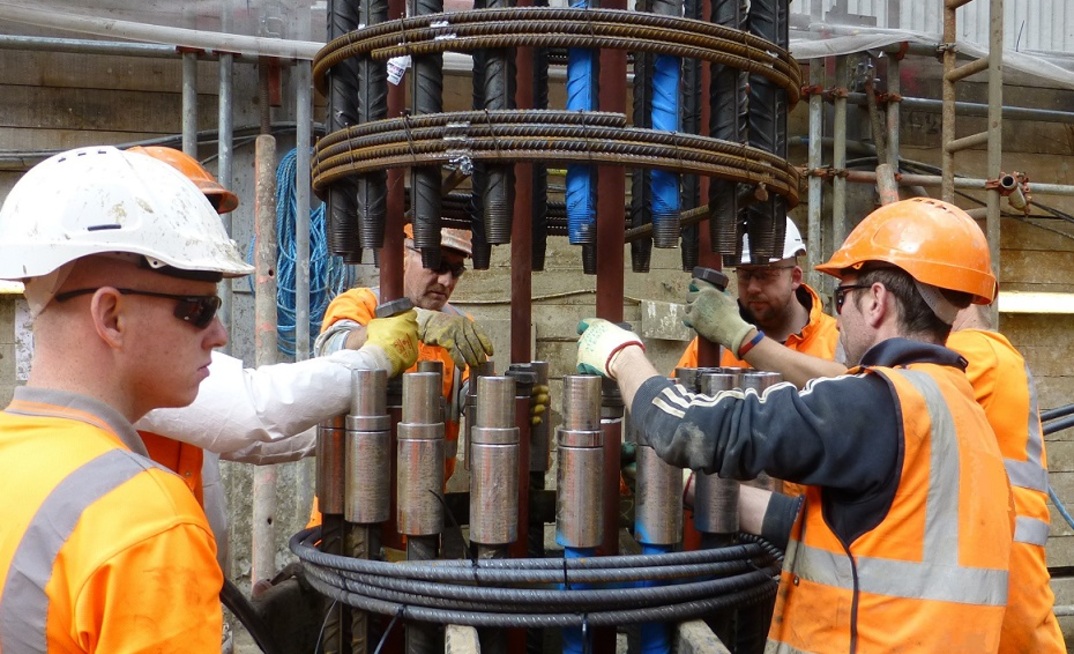Cross-hole sonic logging in large-diameter rotary bored piles is well established in the UK. Alternative methods of ‘seeing into' completed piles are also available, such as dynamic testing and thermal integrity profiling (TIP testing); however, each has its own limitations.
All are by necessity indirect tests. They measure a parameter such as the time taken for sonic waves to pass across a pile section, or the changing thermal profile within the concrete of a pile as it cures. Such test methods do not definitively identify features or defects in a pile, and evaluation of the results requires experience and engineering judgment when results are complicated or inconclusive.
Sonic logging retains a highly undesirable downside in terms of safety. While sonic logging is common, the downside requires urgent attention from specifiers, practitioners and operational businesses in order to render the practise safe, or to accelerate the validation of an alternative method of testing.
Logging tubes
Sonic logging requires the installation of four or more full-length steel tubes in the pile. These tubes are usually fixed to the reinforcement cage. Many bearing pile schemes involve long, bored piles dictating cages of two or three sections or more. The assembly of these cages requires the bottom section to be suspended in the pile or in a ‘rat hole'. The next section is then lifted into place and spliced. The new whole is then lowered into the bore, suspended and the process repeated for the next section.
Piling contractors and reinforcement suppliers have made great strides in developing safe and simple-to-use splicing systems. These have in many situations eliminated the need for hands and arms to be inserted into the cage to attach bolted clips and fixing brackets.
Sonic logging tubes, however, still present a major hazard.
The tubes sit within the reinforcement cage, rigidly attached to the inside of the bars or the cage helical or bands. This is essential as logging is sensitive to accuracy of positioning and divergence or convergence of adjacent tubes. The telescopic tubes are held up above the splice with ties until released, when they are free to slide down a given distance in order to enable jointing of the tubes. The tubes are usually a screw fit to be watertight and to bar the entry of grout and concrete. Some tubes are still sealed by wrapping with adhesive tape, prolonging the time operatives have to have their hands inside the cage.
At any time after release, a momentarily jammed tube can free itself and fall. A 60kg tube falling 1m under gravity can cause serious injuries. A team concentrating on one jammed tube amongst 20-plus spliced cage bars can take their eyes off the alignment of another tube. Fixing brackets for the tube can spring off the more flexible cage and fall from height. There are far too many cases of tubes subjected to unexpected loads during handling, catching on other parts of the cage or on the ground. These can then fall out of the cage during the lift.
Piling contractors and reinforcement fabricators have worked hard to mitigate the risks; stirrup bars and impact blocks are welded into cages to act as stops for sliding tubes, and different ways of screwing the tubes together have been tested. However, the fundamental risk has not been removed.
Over the years operatives have lost fingers and thumbs in the course of this operation. People have suffered hand injuries when using stilsons to tighten tubes while keeping their hands out of the cage.
Solutions
So is this simply a matter for the piling contractors, cage designers and fabricators? We do not believe so. Ultimately a ‘flexible' reinforcement cage is incompatible with rigid tubes attached within it that require operatives to use their hands to join them. Tubes attached to dummy cages inserted after the main cage have been tried, but the need to join tubes still remains.
The requirement to align multiple cage bars, any of which can catch on each other, calls for concentration from operatives. They cannot watch 20-plus bars and four tubes at the same time. There is plenty of opportunity for spacer bars and temporary brackets to come loose and fall. The whole process is unforgiving of any momentary lack of attention at any stage.
Work is being undertaken in finding and developing quick, push-fit couplers for sonic tubes. These, however, are bulky and when combined with the bracketry, hoops and multiple bars in heavy cages, and could generate a problem for concrete flow around and through cages, thereby increasing the risk of generating the very defects that the testing is being employed to check for.
When the place of sonic logging as a first choice is questioned, the reasonable response from specifiers and validators is to cite insufficient correlation between sonic logging results and alternative methods of testing. A concerted effort is needed to review the way confidence in the integrity of large-diameter, deep piles is assessed. Urgent correlation of TIP testing results and sonic-testing logging results is one way to gain confidence in an alternative testing method that removes the hazard of installing sonic logging tubes; but any change in integrity testing approaches must involve the specifiers and be supported by FPS members.
John Chick is on the Quarterly Committee for the Federation of Piling Specialists, UK's industry body for piling and foundation contractors and geotechnical specialists


















